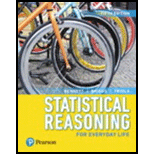
Public Health
Is Your Lifestyle Healthy?
Consider the following findings from statistical studies:
- Smoking increases the risk of heart disease.
- Exercise reduces the risk of heart disease, stroke, osteoporosis, and many cancers.
- One glass of wine per day can protect against heart disease but increases the risk of breast cancer.
- Potato chips and sugary sodas are the foods most strongly associated with weight gain.
You are probably familiar with some of these findings, and perhaps you’ve even altered your lifestyle as a result of them. But where do they come from? Remarkably, these and hundreds of other important findings on public health come from huge prospective studies that have provided data for hundreds of smaller statistical studies. The longest-running of the prospective studies is the Harvard Nurses’ Health Study, which began in 1976 when Dr. Frank E. Speizer decided to study the long-term effects of oral contraceptives. He mailed questionnaires to approximately 370,000 registered nurses and received more than 120,000 responses. He chose to survey nurses because he believed that their medical training would make their responses more reliable than those of the general public.
As Dr. Speizer and his colleagues sifted through the data in the returned questionnaires, they realized that the study could be expanded to include more than just the effects of contraceptives. Today, this research team continues to follow many of the original 120,000 respondents, and it has been expanded to follow hundreds of thousands of additional nurses.
Annual questionnaires are still a vital part of the study, allowing researchers to gather data about what the nurses eat; what medicines and vitamins they take; whether and how much they exercise, drink, and smoke; and what illnesses they have contracted. Some of the nurses also provide blood samples, which are used to measure such things as cholesterol level, hormone levels, genetic variations, and residues from pesticides and environmental pollutants. Dr. Speizer’s faith in nurses has proven justified, as they reliably complete surveys and almost always provide properly drawn and labeled blood samples upon request.
After nearly five decades of correspondence, both the researchers and the nurses say they feel a sense of closeness. Many of the nurses look forward to hearing from the researchers and say that the study has helped them to pay more attention to how they live their lives. Today, as the original nurses become elderly, the study is beginning to turn out results that should shed light on factors that influence longevity and health in old age.

The success of the Harvard Nurses’ Health Study has spurred its expansion and the initiation of many similar studies of large groups. When you see statistical reports based on these studies, remember the hundreds of thousands of people whose willingness to participate in these studies is making life better for everyone.
Explain why the Harvard Nurses’ Health Study is an observational study. Critics sometimes say that the results would be more valid if obtained by experiments rather than observations. Discuss whether it would be possible to gather similar data by carrying out experiments in a practical and ethical way.
Want to see the full answer?
Check out a sample textbook solution
Chapter 1 Solutions
Statistical Reasoning for Everyday Life, Books a la Carte Edition, Plus NEW MyLab Statistics with Pearson eText -- Access Card Package (5th Edition)
 Functions and Change: A Modeling Approach to Coll...AlgebraISBN:9781337111348Author:Bruce Crauder, Benny Evans, Alan NoellPublisher:Cengage Learning
Functions and Change: A Modeling Approach to Coll...AlgebraISBN:9781337111348Author:Bruce Crauder, Benny Evans, Alan NoellPublisher:Cengage Learning Linear Algebra: A Modern IntroductionAlgebraISBN:9781285463247Author:David PoolePublisher:Cengage Learning
Linear Algebra: A Modern IntroductionAlgebraISBN:9781285463247Author:David PoolePublisher:Cengage Learning Glencoe Algebra 1, Student Edition, 9780079039897...AlgebraISBN:9780079039897Author:CarterPublisher:McGraw Hill
Glencoe Algebra 1, Student Edition, 9780079039897...AlgebraISBN:9780079039897Author:CarterPublisher:McGraw Hill Big Ideas Math A Bridge To Success Algebra 1: Stu...AlgebraISBN:9781680331141Author:HOUGHTON MIFFLIN HARCOURTPublisher:Houghton Mifflin Harcourt
Big Ideas Math A Bridge To Success Algebra 1: Stu...AlgebraISBN:9781680331141Author:HOUGHTON MIFFLIN HARCOURTPublisher:Houghton Mifflin Harcourt



